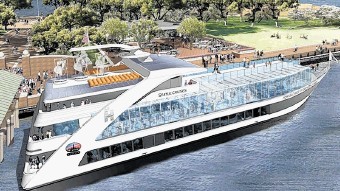
Scottish Enterprise wishes to commission a feasibility study to evaluate the technical and commercial possibilities of using hydrogen fuel cells to enable the development of zero emission ferries.
The feasibility study will be used to apply for European Union funding for the development of a zero emission ferry under the EU-FCH-JU call which is expected next month.
SE claims the EU project will put Scotland at the forefront of global developments in sustainable ferries and could result in design, development and manufacturing of hybrid engines being located here.
However, the UK is already trailing other countries in the development of fuel cell-powered vessels. Even Turkey has an experimental craft operating. This was developed over a period of four years by Istanbul Technical University and was launched in January.
Marti is fuelled by one 8kW Hydrogenics HD8-500 fuel cell power module and includes storage of 20kg at 200bar pressure. The new boat can operate for 10 hours on 5kg of hydrogen with a maximum speed of 13 km/h.
It is used on the Golden Horn estuary in Istanbul, shuttling between various wharfs and the Rahmi M. Koc Museum.
SE points out in a market call notice that Scotland’s ferries are an essential community service and transport infrastructure carrying passengers, cars and freight.
The quango claims that Scotland has a vibrant marine industry sector assessed to have involvement from around 490 companies.
SE says too that it is considering a number of projects which will focus on cost-efficient, innovative and environmentally-friendly vessels and port infrastructure which will benefit Scotland’s rural and island communities.
In recent years, there has been increasing interest in using hydrogen for delivering lower carbon energy systems which can be used in transportation, distributed heat and power generation and energy storage systems.
Up until now, hydrogen has usually been manufactured using fossil fuels, through a steam reforming process which generates CO2 emissions.
However, hydrogen can also be produced through the electrolysis of water using electricity generated from renewable resources such as wind, hydro, solar, biomass and geothermal. This renewable hydrogen can then be used in power generation systems including fuel cells for transportation applications.
Hydrogen and fuel cells are still regarded as emerging technologies and projects still tend to be subsidised by government.
In Scotland, the direct economic activity related to the hydrogen and fuel cells sector is believed to be very small. A study commissioned by the Hydrogen Energy Group in 2006 estimated that around 100 people in Scotland were working in this area.
There have been plans for a road-based hydrogen transport project in the north-east for a number of years. The Energetica initiative which focuses on the development corridor between Aberdeen and Peterhead included proposals for hydrogen transportation in its 2008 strategic framework.
This led to a successful EU funding bid for a proposed demonstration project for hydrogen fuel cell buses in the Aberdeen area.
SE claims that the learning from this road-based project has led to the proposition that the same technology path could be followed in marine applications, leading to the possible development of zero emission ferries.
It now wants to investigate the technical and commercial feasibility of this proposition.
